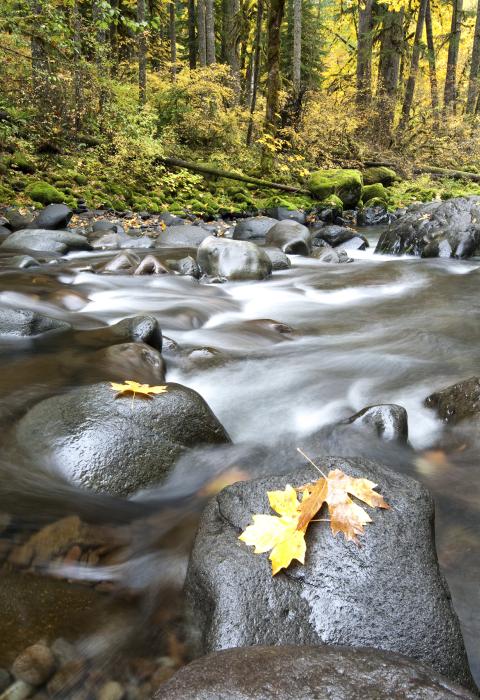Molalla River
Oregon
Springing from its headwaters in northern Oregon's Cascade Range, the cold, clear waters of the Molalla River traverse across both public and private lands to eventually reach the confluence with the Willamette River. Located just an hour away from the greater Portland and Salem metro areas, the designated segment of the Molalla River feels like a world apart. In addition to providing clean drinking water for the cities of Molalla and Canby, this river hosts a diversity of critical habitat values and provides the setting for exceptional year-around recreation opportunities. Administered by the U.S. Bureau of Land Management (BLM), thousands of visitors come to the Molalla River corridor to enjoy hiking, whitewater boating, fishing, camping, or just simply to take in the sights and sounds of this free-flowing river.
The river offers more than recreation, though. Complementing the abundance of diverse wildlife, unique geological features, and wealth of scenic attractions, the Molalla River provides critical spawning and rearing habitat for wild winter steelhead, salmon, and native cutthroat trout. This river, along with the BLM's Table Rock Wilderness, are landscapes of important cultural and historic significance. Reaching back thousands of years, the river corridor has been used as an east-west travel and trade route, linking the peoples of the Willamette Valley to those of the high desert region of eastern Oregon.
BLM administrative studies in 1990 determined that the mainstem Molalla River and the Table Rock Fork were eligible for wild and scenic river designation. The mainstem Molalla's outstandingly remarkable values (ORV) were identified as scenic and recreational, while the Table Rock Fork's ORVs were identified as scenic and cultural. A 1994 suitability assessment of the mainstem Molalla found the river segment to be suitable for wild and scenic river designation, with scenic, recreational, and geologic ORVs. The Table Rock Fork Molalla was determined to be suitable for designation in 2016, with scenic and cultural ORVs. In 2019, the John D. Dingell Jr. Conservation, Management and Recreation Act (Public Law 116-9; Dingell Act) designated a 15.1-mile segment of the mainstem and 6.2-mile segment of the Table Rock Fork Molalla to be managed as a recreational river by the Secretary of the Interior.
This river has also been designated an Oregon State Scenic Waterway.
Designated Reach
March 12, 2019. From the southern boundary line of T 7 S, R 4 E, Section 19, downstream to the edge of the Bureau of Land Management boundary in T 6 S, R 3 E, Section 7. The Table Rock Fork of the Molalla River from the easternmost Bureau of Land Management boundary line in the NE 1/4 Section 4, T 7 S, R 4 E downstream to the confluence with the Molalla River.
Outstandingly Remarkable Values
Preliminary Finding
Culture
The Molalla River's cultural outstandingly remarkable value is based on the high density of cultural sites within the river corridor.
Preliminary Finding
Fish
The Molalla River provides critical habitat for upper Willamette River spring chinook salmon and upper Willamette River winter steelhead trout, which are both present in the designated segment. A designated tributary of the Molalla, the Table Rock Fork produces approximately one-third of the extant native run of winter steelhead reared within the Molalla River Basin. Other salmonid species using the river include native resident cutthroat and rainbow trout.
Preliminary Finding
Geology
A series of horizontal columnar basalt rosettes provide a unique regional example of this type of geologic feature. The Molalla River rosettes are particularly unusual, because they have been exposed to the erosional processes of the river itself and can be easily interpreted and observed by visitors.
Preliminary Finding
Recreation
The Molalla River is one of the top recreational river areas within the mid-Willamette Valley region, drawing recreationalists from outside the region to enjoy its excellent tubing, swimming, wading, sunbathing, fishing, hiking, horseback riding, whitewater boating, and mountain bike riding opportunities. There are more than 30 miles of non-motorized trails, which facilitate access to numerous waterfalls and scenic vistas.
Preliminary Finding
Scenery
The highly rated scenery of the Molalla River is characterized by a broad diversity of colors and textures, from grays and blacks on basalt rock outcrops to the greens and browns of different vegetation types present within the viewshed. The river's scenic character ranges from clear pools to riffles and whitewater, with large moss-covered boulders and diverse streamside vegetation adding to the scenic quality. The human influences that detract from the scenic views of the surrounding valley are limited.

